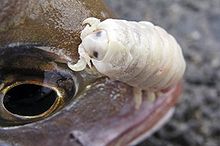- Cymothoa exigua
-
Cymothoa exigua 
Scientific classification Kingdom: Animalia Phylum: Arthropoda Subphylum: Crustacea Class: Malacostraca Order: Isopoda Family: Cymothoidae Genus: Cymothoa Species: C. exigua Binomial name Cymothoa exigua
(Schiødte & Meinert, 1884)Cymothoa exigua, or the tongue-eating louse, is a parasitic crustacean of the family Cymothoidae. It tends to be 3 to 4 centimetres (1.2 to 1.6 in) long. This parasite enters through the gills, and then attaches itself at the base of the spotted rose snapper's (Lutjanus guttatus) tongue. It extracts blood through the claws on its front, causing the tongue to atrophy from lack of blood. The parasite then replaces the fish's tongue by attaching its own body to the muscles of the tongue stub. The fish is able to use the parasite just like a normal tongue. It appears that the parasite does not cause any other damage to the host fish.[1] Once C. exigua replaces the tongue, some feed on the host's blood and many others feed on fish mucus. This is the only known case of a parasite functionally replacing a host organ.[1] It is currently believed that C. exigua are not harmful to humans unless picked up alive, in which case they can bite.[2] There are many species of Cymothoa,[3] but only C. exigua is known to consume and replace its host's tongue.
In 2005, a fish parasitised by what could be Cymothoa exigua was discovered in the United Kingdom. As the parasite is normally found off the coast of California, this led to speculation that the parasite's range may be expanding;[4] however, it is also possible that the isopod traveled from the Gulf of California in the snapper's mouth, and its appearance in the UK is an isolated incident. A tongue louse remains part of the collections of the Horniman Museum,[5] although it is not currently on display.
References
- ^ a b R. C. Brusca & M. R. Gilligan (1983). "Tongue replacement in a marine fish (Lutjanus guttatus) by a parasitic isopod (Crustacea: Isopoda)". Copeia 3 (3): 813–816. doi:10.2307/1444352. JSTOR 1444352.
- ^ "Rare tongue-eating parasite found". BBC News. September 9, 2009. http://news.bbc.co.uk/2/hi/europe/jersey/8246001.stm.
- ^ Vernon E. Thatcher, Gustavo S. de Araujo, José T. A. X. de Lima & Sathyabama Chellappa (2007). "Cymothoa spinipalpa sp. nov. (Isopoda, Cymothoidae) a buccal cavity parasite of the marine fish, Oligoplites saurus (Bloch & Schneider) (Osteichthyes, Carangidae) of Rio Grande do Norte State, Brazil" (PDF). Revista Brasileira de Zoologia 24 (1): 238–245. doi:10.1590/S0101-81752007000100032. http://www.scielo.br/pdf/rbzool/v24n1/32.pdf.
- ^ "Tongue-eating bug found in fish". BBC News. September 2, 2005. http://news.bbc.co.uk/cbbcnews/hi/newsid_4200000/newsid_4209000/4209004.stm.
- ^ "Tongue-eating louse found on supermarket snapper". Practical Fishkeeping. September 6, 2005. http://www.practicalfishkeeping.co.uk/content.php?sid=704.
Categories:- Cymothoida
- Parasitic animals
- Animals described in 1884
Wikimedia Foundation. 2010.
